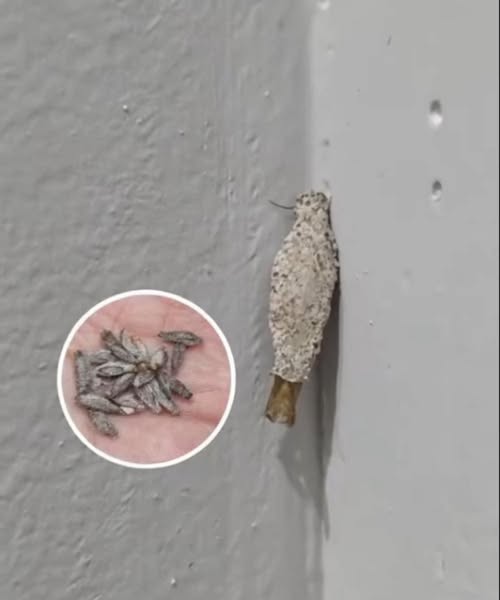For homeowners, few things are more frustrating than discovering tiny, persistent pests that seem to come from nowhere. One such unwelcome visitor is the kamitetep, commonly known as the household casebearer or plaster bagworm.
These little moth larvae don’t bite, sting, or spread illness, but they can quietly damage fabrics, leave unsightly cases hanging from walls or ceilings, and make a home feel less clean and comfortable. For older adults who take pride in maintaining a neat household, understanding the factors that contribute to kamitetep infestations is the first step toward prevention.

By knowing what attracts these pests and how to address it, you can enjoy a tidier, healthier living environment—without the stress of constant cleanups or fabric damage.
Why Kamitetep Appear Indoors
Kamitetep moth larvae are scavengers by nature. Instead of feasting on food crumbs like ants or roaches, they prefer to eat softer, organic materials such as:
- Pet hair and human hair
- Dust and lint
- Dead skin flakes
- Natural fabrics like wool, silk, or felt
If these resources are available, and if the environment feels safe and humid, populations can grow quickly. For seniors living in long-occupied homes with lots of stored belongings, the risk can be even higher.
1. Humidity and Moisture
One of the biggest risk factors for a kamitetep infestation is indoor humidity. These pests thrive in damp, poorly ventilated spaces such as:
- Bathrooms without exhaust fans
- Basements with little airflow
- Kitchens or laundry areas where moisture lingers
- Spaces under sinks or behind appliances
Moisture encourages not only the larvae themselves but also the growth of mold and dust, both of which serve as an additional food supply.
What to do:
- Use a dehumidifier in damp areas.
- Make sure bathrooms and kitchens have proper ventilation systems.
- Inspect under sinks regularly for leaks that could create moist hiding spots.
Reducing moisture not only discourages pests but also helps protect your home from mold and improves overall indoor air quality—a win-win for both comfort and health.
2. Accumulation of Organic Debris
Kamitetep larvae thrive in homes where dust, lint, and pet hair accumulate. Even if a home looks tidy at first glance, debris can build up in hidden areas:
- Under heavy furniture
- Behind cabinets
- Along baseboards
- Inside air vents
For seniors who may find vacuuming and moving furniture physically challenging, these hidden spots can go unchecked for months or even years. Unfortunately, that makes them perfect feeding grounds.
What to do:
- Vacuum weekly, especially in corners and along wall edges.
- Use a HEPA-filter vacuum to trap the fine particles these larvae feed on.
- Consider professional cleaning services for deep cleanings a few times a year.
3. Presence of Fabric and Textiles
Another factor is the availability of natural fabrics. Wool sweaters, silk scarves, felt hats, and wool rugs are all favorites of kamitetep larvae. Items stored in attics, basements, or the backs of closets can be especially vulnerable if left undisturbed.
Even cotton or synthetic fabrics, while less appealing, may be chewed if larvae cannot find better options.
What to do:
- Store wool, silk, and other natural fabrics in airtight containers.
- Use cedar blocks or lavender sachets in closets for natural pest deterrence.
- Wash or dry clean seasonal clothing before storing, since body oils and sweat can attract pests.
4. Clutter and Undisturbed Spaces
Like many pests, kamitetep prefer quiet, hidden corners. Piles of newspapers, stacks of cardboard boxes, or little-used furniture create excellent cover.
Clutter is not just a storage issue—it also means less air circulation and more trapped dust, giving pests exactly what they need to thrive.
What to do:
- Declutter unused spaces regularly.
- Avoid storing cardboard boxes directly on floors—use plastic bins instead.
- Rotate and air out stored items a few times each year.
For seniors, downsizing clutter can also make a home safer by reducing fall hazards and making cleaning easier.
5. Lack of Regular Inspection and Maintenance
Small infestations often go unnoticed for long periods. Because kamitetep larvae hide inside their tiny protective cases, they may look like bits of lint hanging from ceilings, walls, or furniture. Without regular inspection, they can multiply quietly.
What to do:
- Check behind furniture and inside closets once a month.
- Inspect fabrics and rugs for signs of damage.
- Look for small, grayish cases attached to ceilings, curtains, or stored items.
Catching problems early saves time, money, and frustration.
6. Climate and Seasonal Patterns
Kamitetep populations thrive in warm, humid conditions. During summer months, infestations may grow quickly, especially in southern states or coastal regions. Even in winter, heated homes with moisture issues can remain attractive environments.
What to do:
- Adjust thermostat and humidity levels to discourage pests.
- Use ceiling fans or HVAC systems to keep air circulating.
- Schedule seasonal deep cleanings in spring and fall, when infestations are most likely to grow.
7. Pets as a Factor
Homes with cats, dogs, or other furry companions often provide extra food sources for kamitetep larvae. Pet hair, dander, and shed skin can collect in corners, carpets, and furniture, creating a perfect buffet.
What to do:
- Groom pets regularly to reduce shedding.
- Vacuum upholstery and carpets more often in pet-friendly homes.
- Consider washable slipcovers for couches and chairs.
Having pets doesn’t mean you’ll have an infestation—it just means more frequent cleaning is necessary to stay ahead of it.
How to Prevent Kamitetep in the Home
While the list of risk factors may seem long, the good news is that simple, consistent cleaning and maintenance practices can prevent infestations from taking hold.
Here are some effective prevention strategies:
- Vacuum weekly, paying attention to hidden corners.
- Reduce humidity with fans, dehumidifiers, or HVAC adjustments.
- Store fabrics properly, especially natural textiles.
- Declutter storage areas and avoid long-term piles of paper or cardboard.
- Inspect regularly to catch early signs of activity.
For seniors who may not be able to handle all these tasks on their own, home maintenance services or help from family members can make a big difference. Not only does it help control pests, but it also ensures a healthier, more comfortable living environment overall.
Kamitetep infestations don’t happen overnight. They build slowly, thriving in the right conditions of humidity, clutter, organic debris, and fabric storage. But with awareness and a few proactive habits, these pests can be kept under control.
Whether you live in a suburban home, a retirement community, or a smaller apartment, the principles are the same: keep things clean, reduce clutter, and monitor hidden spaces.
A well-kept home is not only more enjoyable to live in—it also protects your belongings, your comfort, and your peace of mind.


